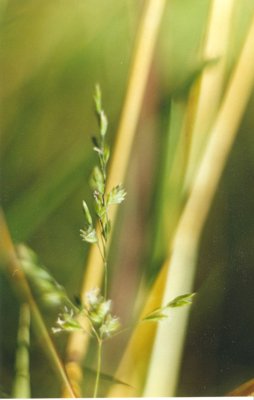Relatives
Poa pratensis L. - Kentucky bluegrass.
Taxonomic position.
Family Poaceae Barnh., genus Poa L.Synonyms.
Poa paratunkensis Kom., P. angustiglumis Roshev., P. subglabriflora Roshev., P.articulata Ovcz., P. maydelii Roshev., P. pinegensis Roshev., P. urjanchaica Roshev., P. garanica Ikonn.Morphology and biology.
Perennial herbaceous plant, grows solitary or in groups, assembled into loose tussocks, with shoots and creeping root. Stems are (15) 20-80 (120) cm tall, terete, smooth. Leaf blades are 2-4(5) mm wide, flat or conduplicate, shortly acuminate. Blades of upper leaves are 2-3 times shorter than their sheaths. The ligule is 0.5-2(4) mm long, obtuse. The inflorescence is a pyramidal panicle, 5-20 cm long. Spikelets are 3.5-7 mm long, with 3-5(7) flowers. Glumes are 1.5-4.5 mm long, with 1-3 veins, lanceolate, sharp. The upper glume has elongated, but not torulose, aciculae along the carina. The lemma is 2.5-4.3 mm long, lanceolate, with five veins, without noticeable intermediate veins, pilose along the carina and in the lower part along the outermost veins, with (on the callus) a tuft of long, tortuous hairs at the base. The palea has aciculae along the carinae. This species is exceptionally polymorphous. Wind- and self-pollinated plant. Autochore. Propagated by seed. Blossoms in June-July; bears fruit in July-August. 2n = 28, 52, 56, 62, 70.Distribution.
Widespread in the northern hemisphere. Occurs in nearly all of Europe, in most of northern Asia (absent in the steppe and desert zones, but occurs in mountainous areas), North America, and the southern part of South America. Naturalized or adventitiously introduced in many other non-tropical countries.Ecology.
Grows in meadows, in thin, light forests, in marshes, in glades, along forest edges, along the banks of reservoirs, near roads and in wastelands. Capable of forming pure thickets.Utilization and economic value.
Good forage plant both for pastures and hay production. Nutritious, readily consumed by livestock. Ranked among early precocious species. Frost- and drought-resistant, endures short-term floods. Vegetates until late autumn.References:
Brezhnev D.D., Korovina O.N. 1981. Wild relatives of cultivated plants in the flora of the USSR. Leningrad: Kolos, p. 35 (in Russian).Gubanov I.A., Kiseleva K.V., Novikov V.S., Tikhomirov V.N. 2002. Illustrated directory of plants in Central Russia. Moscow: Partnership of Scientific Publications KMK, Institute of Technological Research, p. 291. (in Russian).
Tsvelev N.N. 1976. Cereal grasses of the USSR. Leningrad, Nauka, 788 pp. (in Russian).


